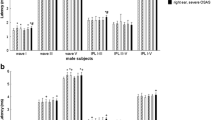Abstract
Objective
Because of their high metabolic activity and low-resting oxygen tension, the organs of the inner ear are vulnerable to hypoxia, a condition that occurs repetitively in obstructive sleep apnea-hypopnea syndrome (OSAHS). The present study aimed to investigate the inner ear function of patients with OSAHS.
Methods
A total of 58 patients with OSAHS (116 ears) and 20 adults without OSAHS were enrolled in the present study. The clinical features, such as air-conduction thresholds, auditory brainstem response (ABR, 11 times/s and 51 times/s stimulation rates), and distorted products otoacoustic emission (DPOAE), were evaluated and compared between these two groups.
Results
Air-conduction thresholds at 4 kHz and 8 kHz were higher in patients with OSAHS compared with controls (P < 0.001). At the rate of 11 times per second, biauricular wave I latencies and wave V latencies in the OSAHS group were longer than those in the control group (1.51 ± 0.13 vs. 1.33 ± 0.07 ms, P < 0.001; 5.65 ± 0.23 vs. 5.53 ± 0.23 ms, P = 0.0016). At the rate of 51 times per second, biauricular wave I latencies and wave V latencies in the OSAHS group were longer than those in the control group (1.64 ± 0.12 vs. 1.44 ± 0.06 ms, P = 0.0001; 5.92 ± 0.26 vs. 5.80 ± 0.18 ms, P = 0.0077). However, there was no significant difference in the wave I and wave V interval between these two groups (P = 0.10). DPOAE amplitude was significantly reduced in OSAHS patients, although no hearing loss was observed.
Conclusion
High-frequency hearing loss was detected in adults with severe OSAHS, and wave I latencies and wave V latencies of ABR were prolonged.
Similar content being viewed by others
References
Chen X, Sun J, Yuan W, Li J (2015) OSAHS obstructive plane localization: comparative study between ag200 and friedman classification. Int J Clin Exp Med 8:2240–2246
Chang Y, Ma Y, Sun S (2015) Clinical observation on effect of auto-CPAP on blood pressure in OSAHS patients. Sleep Med 16:S212–S212
Øhre B, Volden M, Falkum E, Tetzchner VS (2017) Mental disorders in deaf and hard of hearing adult outpatients: a comparison of linguistic subgroups. J Deaf Stud Deaf Educ 22:105–117
Lombardi C, Musicco E, Bettoncelli G, Milanese M, Senna G, Braido F, Canonica GW (2015) The perception of oObstructive sSleep Apnoea/Hypopnoea Syndroms (OSAHS) among Italiangeneral practitioners. Clin Mol Allergy 13:4
Fu Q, Wang T, Liang Y, Lin Y, Zhao X, Wan J, Fan S (2019) Auditory deficits in patients with mild and moderate obstructive sleep apnea syndrome: a speech syllable evoked auditory brainstem response study. Clin Exp Otorhinolaryngol 12:58–65
Yang XH, Xiong XQ, Guo J, Wang YQ, Cui Y, Liang QL (2013) Auditory function after surgical treatments in adult patients with severe OSAHS. Chin J Otol 11:91–95 (in Chinese)
Li XJ, Zhao Y, Li FD, Chen TS, Lu HH, Wang W, Chen Y, Liang RM, Chen C, Zhang JP, Ling P (2016) An analysis of auditory brainstem responses at high stimulate rate in patients with OSAHS. J Audiol Speech Pathol 24:355–359
Zelle D, Lorenz L, Thiericke JP, Gummer AW, Dalhoff E (2017) Input-output functions of the nonlinear-distortion component of distortion-product otoacoustic emissions in normal and hearing-impaired human ears. J Acoust Soc Am 141:3203–3219
Dzierzewski JM, Wallace DM, Wohlgemuth WK (2016) Adherence to continuous positive airway pressure in existing users: self-efficacy enhances the association between continuous positive airway pressure and adherence. J Clin Sleep Med 12:169–176
Matsumura E, Matas CG, Sanches SGG, Magliaro FCL, Pedreño RM, Genta PR, Lorenzi-Filho G, Carvallo RMM (2018) Severe obstructive sleep apnea is associated with cochlear function impairment. Sleep Breath 22:71–77
Ekin S, Turan M, Arısoy A, Gunbatar H, Sunnetcioglu A, Asker S, Yıldız H (2016) Is there a relationship between obstructive sleep apnea (OSA) and hearing loss? Med Sci Monit 22:3124–3128
Zelle D, Dalhoff E, Gummer AW (2017) Objective audiometry with DPOAEs : new findings for generation mechanisms and clinical applications. HNO. 65:122–129
Funding
Talents developing program of Beijing Hospital Authority, No. PX2016031.
Author information
Authors and Affiliations
Corresponding author
Ethics declarations
Disclosure of potential conflicts of interest
All authors declare that they have no potential conflicts of interest to disclose.
Research involving human participants and/or animals
Yes
Informed consent
Obtained
Additional information
Publisher’s note
Springer Nature remains neutral with regard to jurisdictional claims in published maps and institutional affiliations.
Rights and permissions
About this article
Cite this article
Li, X., Chen, WJ., Zhang, XY. et al. Inner ear function in patients with obstructive sleep apnea. Sleep Breath 24, 65–69 (2020). https://doi.org/10.1007/s11325-019-01891-7
Received:
Revised:
Accepted:
Published:
Issue Date:
DOI: https://doi.org/10.1007/s11325-019-01891-7




